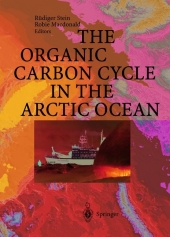 Neuerscheinungen 2013Stand: 2020-01-07 |
Schnellsuche
ISBN/Stichwort/Autor
|
Herderstraße 10
10625 Berlin
Tel.: 030 315 714 16
Fax 030 315 714 14
info@buchspektrum.de |

Robie W. Macdonald, Rüdiger Stein
(Beteiligte)
The Organic Carbon Cycle in the Arctic Ocean
Herausgegeben von Stein, Rüdiger; Macdonald, Robie W.
Softcover reprint of the original 1st ed. 2004. 2013. xix, 363 S. 62 Tabellen. 270 mm
Verlag/Jahr: SPRINGER, BERLIN 2013
ISBN: 3-642-62351-4 (3642623514)
Neue ISBN: 978-3-642-62351-6 (9783642623516)
Preis und Lieferzeit: Bitte klicken
The flux,preservation,and accumulation of organic carbon in marine systems are controlled by various mechanisms including primary p- duction of the surface water,supply of terrigenous organic matter from the surrounding continents, biogeochemical processes in the water column and at the seafloor, and sedimentation rate. For the world s oceans,phytoplankton productivity is by far the largest organic carbon 9 source,estimated to be about 30 to 50 Gt (10 tonnes) per year (Berger et al. 1989; Hedges and Keil 1995). By comparison, rivers contribute 1 about 0. 15 to 0. 23 Gt y of particulate organic carbon (Ittekkot 1988; 1 Hedges et al. 1997). On average,only about 0. 1 0. 2 Gt y of the organic carbon supplied to the world s oceans has been buried in Holocene sediments, with perhaps 85 90% of that being deposited in deltaic, shelf and upper slope sediments (Romankevich 1984; Berner 1989; Hedges and Keil 1995). To refine the global ocean carbon budget in general and,specifically,to quantify organic carbon burial because it is so important for climatic change, we need detailed measurements of the organic carbon flux in all ocean environments, especially for c- tinental margins (e. g. ,Liu et al. ,2000). With the notable exception of the Arctic Ocean, data have been available for some time on organic carbon sources, pathways and burial in a variety of ocean envir- ments.
From the reviews:
"The book is an extraordinary compilation of interesting information and a succession of important interpretations about the production, delivery, degradation, and burial of organic matter in the world´s only polar ocean. ... The three features of the book that make it particularly special are its content, its presentation, and its timeliness. ... Because of the way that Stein and Macdonald have so effectively integrated and organized a wealth of information about the Arctic, many kinds of scientists would benefit from it." (Phillip A. Meyers, Polar Record, Vol. 41 (3), 2005)


